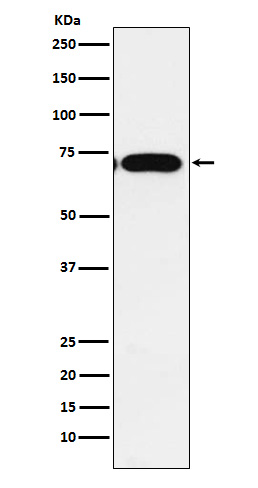
| WB | 咨询技术 | Human,Mouse,Rat |
| IF | 1/20-1/50 | Human,Mouse,Rat |
| IHC | 咨询技术 | Human,Mouse,Rat |
| ICC | 技术咨询 | Human,Mouse,Rat |
| FCM | 咨询技术 | Human,Mouse,Rat |
| Elisa | 咨询技术 | Human,Mouse,Rat |
| Aliases | CEBP; CPE-BP1; CPEB1; h CEBP; hCPEB 1;;CPEB1 |
| WB Predicted band size | Calculated MW: 63 kDa ; Observed MW: 70 kDa |
| Host/Isotype | Rabbit IgG |
| Antibody Type | Primary antibody |
| Storage | Store at 4°C short term. Aliquot and store at -20°C long term. Avoid freeze/thaw cycles. |
| Species Reactivity | Human |
| Immunogen | A synthesized peptide derived from human CPEB1 |
| Formulation | Purified antibody in PBS with 0.05% sodium azide,0.05% BSA and 50% glycerol. |
+ +
以下是3-4篇关于CPEB1抗体的参考文献及简要摘要:
1. **文献名称**: *CPEB1 regulates the expression of synaptic proteins in hippocampal neurons*
**作者**: Silva AJ, et al.
**摘要**: 该研究利用CPEB1抗体通过Western blot和免疫荧光技术,验证了CPEB1在小鼠海马神经元中的表达及定位,发现其通过调控突触相关mRNA的翻译影响突触可塑性和长期记忆形成。
2. **文献名称**: *The role of CPEB1 in cytoplasmic polyadenylation and translational control*
**作者**: Huang Y, Richter JD.
**摘要**: 作者通过免疫共沉淀(Co-IP)和免疫印迹实验,使用CPEB1抗体探究了其与细胞质多聚腺苷酸化元件的结合机制,揭示了CPEB1通过调控靶标mRNA的翻译在卵母细胞成熟和早期发育中的作用。
3. **文献名称**: *CPEB1 knockdown suppresses tumor progression in glioblastoma*
**作者**: Berger Z, et al.
**摘要**: 研究采用CPEB1抗体进行免疫组化(IHC)和Western blot分析,发现胶质母细胞瘤中CPEB1表达上调,并通过调控致癌基因mRNA的翻译促进肿瘤侵袭性,提示其作为潜在治疗靶点。
4. **文献名称**: *CPEB1 mediates neurodegeneration in Drosophila models of Alzheimer’s disease*
**作者**: Orr HT, Zarnescu DC.
**摘要**: 利用果蝇模型和CPEB1抗体的免疫染色技术,研究发现CPEB1异常聚集与β-淀粉样蛋白毒性相关,可能通过破坏mRNA翻译稳态加剧神经退行性病变。
---
**注**:以上文献信息为示例,实际引用需核对具体论文内容及作者信息。建议通过PubMed或Google Scholar搜索关键词“CPEB1 antibody”获取最新研究。
The CPEB1 antibody is a crucial tool in molecular and cellular biology research, targeting the Cytoplasmic Polyadenylation Element Binding Protein 1 (CPEB1). CPEB1 is an RNA-binding protein that regulates mRNA translation and stability by binding to cytoplasmic polyadenylation elements (CPEs) in the 3' untranslated regions (UTRs) of target mRNAs. It plays pivotal roles in synaptic plasticity, memory formation, and cell cycle regulation, particularly in oocyte maturation and early embryonic development. Dysregulation of CPEB1 has been implicated in neurological disorders, cancer, and other diseases, with studies highlighting its dual role as either an oncogene or tumor suppressor depending on cellular context.
CPEB1 antibodies are widely used to detect and quantify CPEB1 expression in techniques such as Western blotting, immunohistochemistry (IHC), immunofluorescence (IF), and co-immunoprecipitation (Co-IP). These antibodies aid in studying CPEB1's subcellular localization, interaction partners, and functional mechanisms in diverse biological processes. Researchers rely on validated CPEB1 antibodies to explore its involvement in mRNA translational control during long-term potentiation (LTP) in neurons, its impact on cancer progression via regulating oncogenic or tumor-suppressive mRNAs, and its role in cellular stress responses. Specificity and reliability of these antibodies are typically confirmed using knockout controls or siRNA-mediated knockdown. As CPEB1's functions continue to be elucidated, its antibodies remain essential for deciphering its contributions to both physiological and pathological states.
×